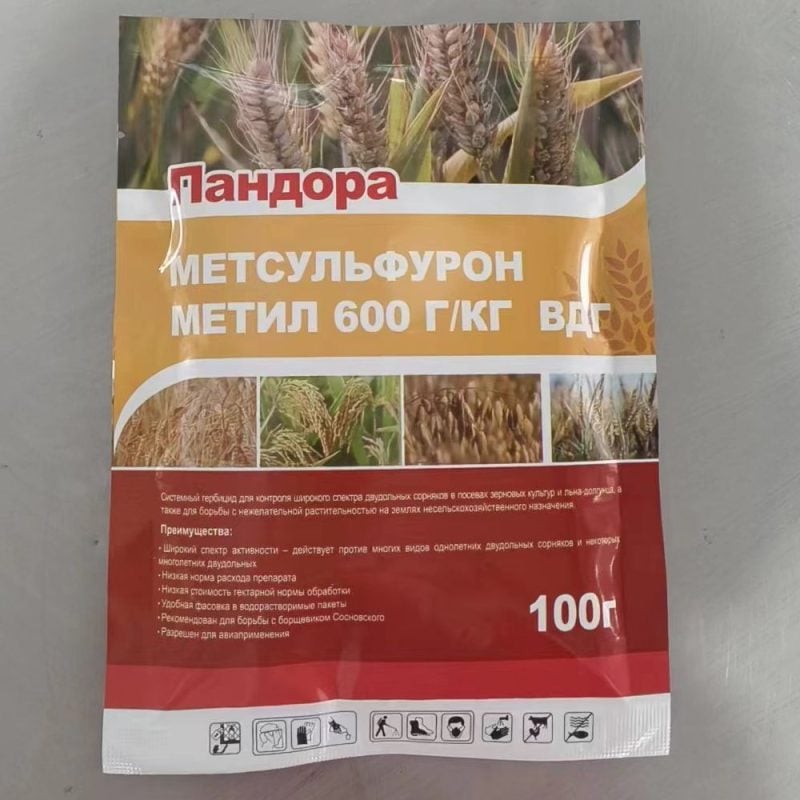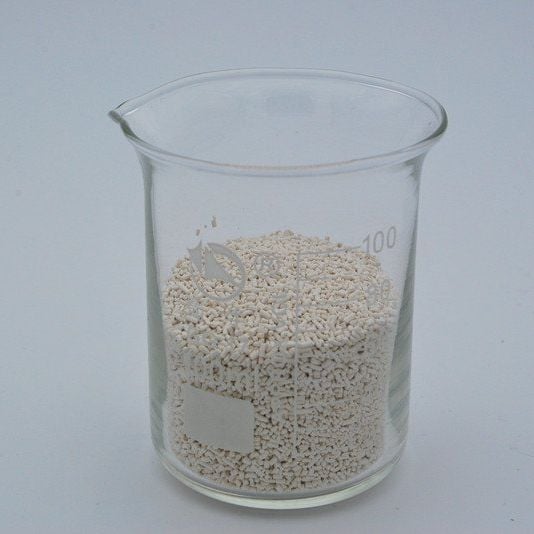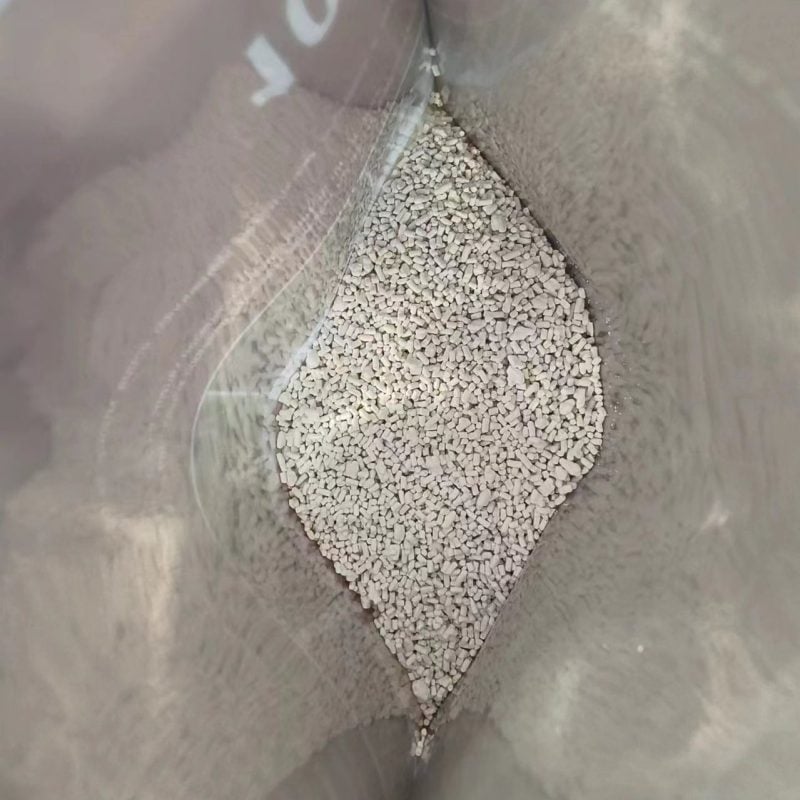Mode of Action of Metsulfuron Methyl
Metsulfuron Methyl belongs to the sulfonylurea (SU) class of herbicides, which are renowned for their high potency at low application rates. The primary mode of action of Metsulfuron Methyl is the inhibition of the enzyme acetolactate synthase (ALS), also known as acetohydroxy acid synthase (AHAS). This enzyme is critical in the biosynthesis of the branched-chain amino acids valine, leucine, and isoleucine, which are essential for protein synthesis and plant growth.
1. Inhibition of ALS Enzyme
- The ALS enzyme plays a key role in the first step of the biosynthesis pathway of these branched-chain amino acids. Without the activity of ALS, the plant is unable to produce these amino acids, which are fundamental building blocks for proteins.
- Specific Binding: Metsulfuron Methyl binds to the ALS enzyme at the active site, preventing its interaction with its natural substrates (pyruvate and 2-ketobutyrate), which would otherwise proceed to form the amino acids.
- Effect on Plant Cells: As ALS is essential for amino acid production, its inhibition disrupts the synthesis of proteins that are required for cell division and growth, particularly in the meristematic regions (growing points) of the plant. This leads to a cessation of cell division and overall plant growth.
2. Systemic Action
Metsulfuron Methyl is a systemic herbicide, meaning that after absorption through the plant’s foliage and roots, it moves via the plant’s vascular system (both xylem and phloem) to the meristematic tissues where it exerts its herbicidal effect.
- Translocation: The herbicide moves upwards and downwards through the plant’s system, ensuring it reaches all actively growing tissues, not just the site of application.
- Targeted Action: The herbicide specifically affects broadleaf weeds (dicots) while being less harmful to grasses (monocots), as many grasses are naturally resistant or tolerant to ALS inhibitors.
3. Delayed Plant Death
After application, the visible symptoms of Metsulfuron Methyl’s effect, such as yellowing and stunted growth, may take several days or even weeks to appear. This is because it is not a fast-acting herbicide; rather, it gradually inhibits plant growth by starving the plant of essential proteins.
- Early Effects: Within a few hours of application, ALS inhibition begins, halting the production of the necessary amino acids.
- Progression: Over time, the lack of amino acids causes the plant to exhaust its existing protein reserves, leading to stunted growth, chlorosis (yellowing), and eventual death. Since cell division is halted, the plant’s meristematic tissues are most affected.
4. Selectivity
Metsulfuron Methyl exhibits high selectivity for certain broadleaf weeds while leaving grasses and some tolerant broadleaf plants relatively unaffected. The differential sensitivity of plants to ALS inhibitors like Metsulfuron Methyl is due to:
- Differential Binding Affinities: Certain plants, such as broadleaf weeds, have ALS enzymes that are highly susceptible to inhibition by Metsulfuron Methyl. In contrast, other plants (grasses and some crops) have ALS enzymes with a lower binding affinity for the herbicide, making them less affected.
- Metabolic Resistance: Some plant species can rapidly metabolize or detoxify Metsulfuron Methyl before it can reach its target site in the ALS enzyme, contributing to natural resistance.
5. Resistance Management
Despite its efficacy, repeated use of Metsulfuron Methyl and other ALS inhibitors has led to the evolution of herbicide-resistant weed populations. This resistance can develop through mutations in the ALS gene, which change the enzyme’s structure, reducing the herbicide’s ability to bind and inhibit it.
- Resistance Mechanisms: The two primary resistance mechanisms observed are:
- Target-Site Resistance: Mutations in the ALS gene prevent Metsulfuron Methyl from effectively binding to and inhibiting the enzyme.
- Non-Target-Site Resistance: Enhanced metabolic degradation of the herbicide, rendering it ineffective before it can inhibit ALS.
To mitigate resistance development, it is recommended to use Metsulfuron Methyl in combination with other herbicides that have different modes of action and to rotate herbicides across growing seasons.
6. Symptoms of ALS Inhibition
Plants exposed to Metsulfuron Methyl exhibit several characteristic symptoms of ALS inhibition:
- Growth Stoppage: The first visible sign is the cessation of new growth, particularly in the meristematic tissues (growing points).
- Chlorosis: Yellowing of the leaves due to nutrient and protein deficiencies as the plant’s metabolic processes are disrupted.
- Necrosis: Over time, the affected tissues will die, leading to browning and death of the entire plant if enough of the herbicide is absorbed and translocated.
Summary
The mode of action of Metsulfuron Methyl involves the inhibition of the ALS enzyme, crucial for the synthesis of essential branched-chain amino acids. Without these amino acids, plants cannot produce proteins necessary for growth, leading to a gradual cessation of growth, chlorosis, and eventual plant death. As a selective herbicide, Metsulfuron Methyl is highly effective against broadleaf weeds while being less harmful to grasses. However, the development of resistance in some weed populations necessitates the careful management of its use in integrated weed control strategies.
Metsulfuron Methyl belongs to the sulfonylurea (SU) class of herbicides, which are renowned for their high potency at low application rates. The primary mode of action of Metsulfuron Methyl is the inhibition of the enzyme acetolactate synthase (ALS), also known as acetohydroxy acid synthase (AHAS). This enzyme is critical in the biosynthesis of the branched-chain amino acids valine, leucine, and isoleucine, which are essential for protein synthesis and plant growth.
1. Inhibition of ALS Enzyme
- The ALS enzyme plays a key role in the first step of the biosynthesis pathway of these branched-chain amino acids. Without the activity of ALS, the plant is unable to produce these amino acids, which are fundamental building blocks for proteins.
- Specific Binding: Metsulfuron Methyl binds to the ALS enzyme at the active site, preventing its interaction with its natural substrates (pyruvate and 2-ketobutyrate), which would otherwise proceed to form the amino acids.
- Effect on Plant Cells: As ALS is essential for amino acid production, its inhibition disrupts the synthesis of proteins that are required for cell division and growth, particularly in the meristematic regions (growing points) of the plant. This leads to a cessation of cell division and overall plant growth.
2. Systemic Action
Metsulfuron Methyl is a systemic herbicide, meaning that after absorption through the plant’s foliage and roots, it moves via the plant’s vascular system (both xylem and phloem) to the meristematic tissues where it exerts its herbicidal effect.
- Translocation: The herbicide moves upwards and downwards through the plant’s system, ensuring it reaches all actively growing tissues, not just the site of application.
- Targeted Action: The herbicide specifically affects broadleaf weeds (dicots) while being less harmful to grasses (monocots), as many grasses are naturally resistant or tolerant to ALS inhibitors.
3. Delayed Plant Death
After application, the visible symptoms of Metsulfuron Methyl’s effect, such as yellowing and stunted growth, may take several days or even weeks to appear. This is because it is not a fast-acting herbicide; rather, it gradually inhibits plant growth by starving the plant of essential proteins.
- Early Effects: Within a few hours of application, ALS inhibition begins, halting the production of the necessary amino acids.
- Progression: Over time, the lack of amino acids causes the plant to exhaust its existing protein reserves, leading to stunted growth, chlorosis (yellowing), and eventual death. Since cell division is halted, the plant’s meristematic tissues are most affected.
4. Selectivity
Metsulfuron Methyl exhibits high selectivity for certain broadleaf weeds while leaving grasses and some tolerant broadleaf plants relatively unaffected. The differential sensitivity of plants to ALS inhibitors like Metsulfuron Methyl is due to:
- Differential Binding Affinities: Certain plants, such as broadleaf weeds, have ALS enzymes that are highly susceptible to inhibition by Metsulfuron Methyl. In contrast, other plants (grasses and some crops) have ALS enzymes with a lower binding affinity for the herbicide, making them less affected.
- Metabolic Resistance: Some plant species can rapidly metabolize or detoxify Metsulfuron Methyl before it can reach its target site in the ALS enzyme, contributing to natural resistance.
5. Resistance Management
Despite its efficacy, repeated use of Metsulfuron Methyl and other ALS inhibitors has led to the evolution of herbicide-resistant weed populations. This resistance can develop through mutations in the ALS gene, which change the enzyme’s structure, reducing the herbicide’s ability to bind and inhibit it.
- Resistance Mechanisms: The two primary resistance mechanisms observed are:
- Target-Site Resistance: Mutations in the ALS gene prevent Metsulfuron Methyl from effectively binding to and inhibiting the enzyme.
- Non-Target-Site Resistance: Enhanced metabolic degradation of the herbicide, rendering it ineffective before it can inhibit ALS.
To mitigate resistance development, it is recommended to use Metsulfuron Methyl in combination with other herbicides that have different modes of action and to rotate herbicides across growing seasons.
6. Symptoms of ALS Inhibition
Plants exposed to Metsulfuron Methyl exhibit several characteristic symptoms of ALS inhibition:
- Growth Stoppage: The first visible sign is the cessation of new growth, particularly in the meristematic tissues (growing points).
- Chlorosis: Yellowing of the leaves due to nutrient and protein deficiencies as the plant’s metabolic processes are disrupted.
- Necrosis: Over time, the affected tissues will die, leading to browning and death of the entire plant if enough of the herbicide is absorbed and translocated.
Summary
The mode of action of Metsulfuron Methyl involves the inhibition of the ALS enzyme, crucial for the synthesis of essential branched-chain amino acids. Without these amino acids, plants cannot produce proteins necessary for growth, leading to a gradual cessation of growth, chlorosis, and eventual plant death. As a selective herbicide, Metsulfuron Methyl is highly effective against broadleaf weeds while being less harmful to grasses. However, the development of resistance in some weed populations necessitates the careful management of its use in integrated weed control strategies.






